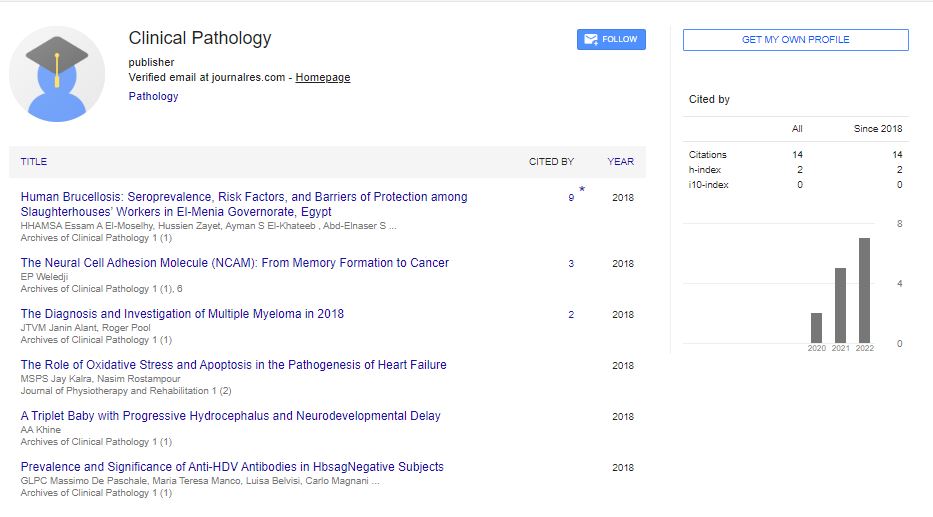Short Communication, Arch Clin Pathol Vol: 6 Issue: 4
Navigating the Landscape of Clinical Virology: Insights into Viral Infections
Richard Cameroon*
1Department of Internal Medicine, The Ohio State University, Columbus, USA
*Corresponding Author: Richard Cameroon,
Department of Internal Medicine,
The Ohio State University, Columbus, USA
E-mail: cameroonrichard@gmail.com
Received date: 27 November, 2023, Manuscript No. ACPY-24-124242;
Editor assigned date: 30 November, 2023, PreQC No. ACPY-24-124242 (PQ);
Reviewed date: 13 December, 2023, QC No. ACPY-24-124242;
Revised date: 21 December, 2023, Manuscript No. ACPY-24-124242 (R);
Published date: 28 December, 2023 DOI: 10.4172/acpy.100106
Citation: Cameroon R (2023) Navigating the Landscape of Clinical Virology: Insights into Viral Infections. Arch Clin Pathol 6:4.
Description
Clinical virology is a specialized field within medical microbiology that focuses on the study, diagnosis, and management of viral infections in humans. Viruses, being microscopic entities, pose unique challenges in their detection, characterization, and treatment. Viruses are infectious agents that exist as small particles containing genetic material, either DNA or RNA, surrounded by a protein coat. Their diverse nature, high mutation rates, and ability to rapidly evolve contribute to their capacity for causing a wide range of diseases. The study of viruses encompasses various families, each with distinct properties, transmission modes, and disease manifestations.
Fundamentals of clinical virology
Clinical virology involves a multifaceted approach to identify and characterize viral infections. Laboratory techniques play a crucial role in this field. Molecular methods, such as Polymerase Chain Reaction (PCR) and nucleic acid sequencing, enable the detection and genetic characterization of viruses. Serological tests detect antibodies produced by the immune system in response to viral infections, aiding in diagnosis and surveillance [1-4].
Viral Culture techniques allow for the isolation and propagation of viruses in laboratory settings, facilitating further studies on viral behavior and susceptibility to antiviral therapies. Antigen detection assays, like Enzyme-Linked Immunosorbent Assays (ELISA) and immunofluorescence, help identify viral proteins in patient samples [5].
Role in disease diagnosis and management
Clinical virology is essential in diagnosing viral infections, ranging from common respiratory viruses like influenza and Respiratory Syncytial Virus (RSV) to complex infections like HIV, hepatitis viruses, and emerging viral threats such as Ebola, Zika, or SARSCoV- 2. Accurate and timely diagnosis enables appropriate patient management, infection control measures, and antiviral therapy initiation where available [6-8].
In addition to diagnosis, clinical virology plays a critical role in epidemiological surveillance. Monitoring viral outbreaks, tracking transmission patterns, and identifying emerging viral strains are vital for public health interventions and vaccine development.
Emerging trends and innovations
The field of clinical virology continues to evolve with technological advancements. Next-Generation Sequencing (NGS) technologies provide a deeper understanding of viral genomes, aiding in the identification of drug-resistant strains and the development of targeted therapies. High-throughput platforms enhance the speed and accuracy of viral detection and characterization [9].
The advent of mRNA vaccine technology, notably highlighted by the successful development of COVID-19 vaccines, showcases the rapid translation of virology research into effective vaccination strategies. Moreover, the integration of artificial intelligence and machine learning algorithms into virology data analysis holds promise in predicting viral evolution, transmission dynamics, and drug development [10].
Challenges and future directions
Clinical virology faces challenges such as the emergence of novel viruses, diagnostic test standardization, and access to advanced diagnostic technologies in resource-limited settings. Antiviral resistance, viral mutations, and vaccine hesitancy contribute to the complexity of managing viral infections.
The future of clinical virology lies in enhancing global surveillance networks, developing broad-spectrum antiviral therapies, and advancing vaccine technologies to combat emerging viral threats. Collaboration among researchers, clinicians, public health agencies, and policymakers is essential to address these challenges.
Conclusion
Clinical virology stands as a cornerstone in understanding, diagnosing, and managing viral infections. Its continuous evolution, driven by technological innovations and interdisciplinary collaborations, remains pivotal in the fight against existing and emerging viral diseases. With ongoing advancements, clinical virology holds the impact of mitigating the impact of viral infections on global health while striving towards improved diagnostics, therapies, and preventive measures.
References
- Schoggins JW (2014) Interferon-stimulated genes: roles in viral pathogenesis. Curr Opin Virol 6:40-46.
[Google Scholar] [PubMed]
- Fensterl V, Sen GC (2015) Interferon-induced fit proteins: their role in viral pathogenesis. J Virol 89(5):2462-2468.
[Google Scholar] [PubMed]
- Martina BE, Koraka P, Osterhaus AD (2009) Dengue virus pathogenesis: an integrated view. Clin Microbiol Rev 22(4):564-581.
[Google Scholar] [PubMed]
- Van der Poll T, Opal SM (2008) Host–pathogen interactions in sepsis. Lancet Infect Dis 8(1):32-43.
- Doherty CP (2007) Host-pathogen interactions: the role of iron. J Nutr 137(5):1341-1344. [Google Scholar]
[PubMed]
- Casadevall A, Pirofski LA (2000) Host-pathogen interactions: basic concepts of microbial commensalism, colonization, infection, and disease. Infect Immun 68(12):6511-6518.
[Google Scholar] [PubMed]
- Enkirch T, Von Messling V (2015) Ferret models of viral pathogenesis. Virol J 479:259-270.
[Google Scholar] [PubMed]
- Ellis JA (2009) Update on viral pathogenesis in BRD. Anim Health Res Rev 10(2):149-153.
[Google Scholar] [PubMed]
- Gottwein E, Cullen BR (2008) Viral and cellular microRNAs as determinants of viral pathogenesis and immunity. Cell host & microbe 3(6):375-387.
[Google Scholar] [PubMed]
- Akaike T (2001) Role of free radicals in viral pathogenesis and mutation. Rev Med Virol 11(2):87-101.
[Google Scholar] [PubMed]
 Spanish
Spanish  Chinese
Chinese  Russian
Russian  German
German  French
French  Japanese
Japanese  Portuguese
Portuguese  Hindi
Hindi 